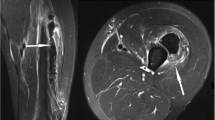Abstract
Magnetic resonance (MR) images of skeletal muscle tears can clearly delineate the severity of muscle injury. Although MR imaging is seldom necessary in patients with acute muscle trauma, it can be helpful in deciding on clinical management. The two major MR findings in acute muscle tears are deformity of the muscle and the presence of abnormal signal reflecting hemorrhage and edema. In acute tears, methemoglobin within the extravascular blood causes high-signal areas on both T1-and T2-weighted images. With partial tears, the blood may dissect in a distinctive linear pattern along the muscle bundles and fibers. As healing begins, the muscle signal diminishes, first on the T1-weighted images and then on the T2-weighted images. When there is residual abnormal signal on images obtained more than several months after the injury, it is presumed to represent hemorrhage from recurrent tears. In patients with a questionable history of a remote injury, the clinical presentation may be that of persistent pain or a soft tissue mass. In these cases MR imaging may identify the cause of the pain and can exclude a neoplasm by proving that the mass is a hypertrophied or retracted muscle. Thus, MR imaging has a limited, but occasionally important role in selected patients with skeletal muscle tears.
Similar content being viewed by others
References
Anouchi YS, Parker RD, Seitz WH Jr (1987) Posterior compartment syndrome of the calf resulting from misdiagnosis of a rupture of the medial head of the gastrocnemius. J Trauma 27:678
Bradley WG Jr, Schmidt PG (1985) Effect of methemoglobin formation on the MR appearance of subarachnoid hemorrhage. Radiology 156:99
De Smet AA, Fisher DR, Heiner JP, Keene JS (1990) Magnetic resonance imaging of muscle tears. Skeletal Radiol 19:283
Deutsch AL, Mink JH (1989) Magnetic resonance imaging of musculoskeletal injuries. Radiol Clin North Am 27:983
Dooms GC, Fisher MR, Hricak H, Higgins CB (1985) MR imaging of intramuscular hemorrhage. J Comput Assist Tomogr 9:908
Dooms GC, Uske A, Berthiaume Y (1986) MR imaging of extracranial hematomas: comparison with CT. Eur J Radiol 6:30
Ehman RL, Bercquist TH (1986) Magnetic resonance imaging of musculoskeletal trauma. Radiol Clin North Am 24:291
Fleckenstein JL, Weatherall PT, Parkey RW, Payne JA, Peshock RM (1989) Sports-related muscle injuries: evaluation with MR imaging. Radiology 172:793
Gomori JM, Grossman RI, Goldberg HI, Zimmerman RA, Bilaniuk LT (1985) Intracranial hematomas: imaging by high-field MR. Radiology 157:87
Greco A, McNamara MT, Escher MB, Trifilio G, Parienti J (1991) Spin-echo and STIR MR imaging of sports-related muscle injuries at 1.5 T. J Comput Assist Tomogr 15:994
Menz MJ, Lucas GL (1991) Magnetic resonance imaging of a rupture of the medial head of the gastrocnemius muscle. J Bone Joint Surg [Am] 73:1260
Motta F, Carletti F (1990) Spontaneous rupture of the infraspinatus muscle: a case report. Int Orthop 14:351
Nurenberg P, Giddings GJ, Stray-Gundersen J, Fleckenstein JL, Gonyea WJ, Peshock RM (1992) MR imaging-guided muscle biopsy for correlation of increased signal intensity with ultrastructural change and delayed-onset muscle soreness after exercise. Radiology 184:865
Pakter RL, Fishman EK, Zerhouni EA (1987) Calf hematoma — computed tomographic and magnetic resonance findings. Skeletal Radiol 16:393
Rubin JI, Gomori JM, Grossman RI, Gefter WB, Kressel HY (1987) High-field MR imaging of extracranial hematomas. AJR 148:813
Swensen SJ, Keller PL, Berquist TH, McLeod RA, Stephens DH (1985) Magnetic resonance imaging of hemorrhage. AJR 145:921
Unger EC, Glazer HS, Lee JKT, Ling D (1986) MRI of extracranial hematomas: preliminary observations. AJR 146:403
Zeiss J, Ebraheim NA, Woldenberg LS (1989) Magnetic resonance imaging in the diagnosis of anterior tibialis muscle herniation. Clin Orthop 244:249
Author information
Authors and Affiliations
Rights and permissions
About this article
Cite this article
De Smet, A.A. Magnetic resonance findings in skeletal muscle tears. Skeletal Radiol. 22, 479–484 (1993). https://doi.org/10.1007/BF00209094
Issue Date:
DOI: https://doi.org/10.1007/BF00209094




